
CONTACTAbout UsCAREER OPPORTUNITIESADVERTISE WITH USPRIVACY POLICYPRIVACY PREFERENCESTERMS OF USELEGAL NOTICE
© 2025 Equal Entertainment LLC.
All Rights reserved
All Rights reserved
By continuing to use our site, you agree to our Privacy Policy and Terms of Use.
We need your help
Your support makes The Advocate's original LGBTQ+ reporting possible. Become a member today to help us continue this work.
Your support makes The Advocate's original LGBTQ+ reporting possible. Become a member today to help us continue this work.
More In This Series
Don Lemon: A Sense of Otherness
Wanda Sykes: On Being Real
Laverne Cox: Threat or Threatened
Twiggy Garcon: Ballroom at 14
Doug Spearman: Breaking the Code
Janora McDuffie: My Obligation
Aaron Walton: Angelic Troublemakers
Editor's Letter: Black and LGBT in America
---
On May 17, Mark Carson, a 32-year-old black gay man in New York City, was murdered in gay-friendly Greenwich Village by homophobes wielding a 38-caliber revolver. I did not know Carson, but I feel I have encountered him on countless occasions. I encounter him when I speak with the young, mostly black and brown people we serve at the Hetrick-Martin Institute where I work. I encounter him when I look in the mirror. My life, like his, like that of many of the kids I work with, has been shaped by the multiple identities that mark me. I am black, but rendered invisible within most mainstream LGBT movements. I am gay and have been ostracized by the homophobia of other black people. I am male and realize that my privileges are not granted to black lesbian and trans women. Like Carson, my personal experiences are often missing from narratives of gay progress.
Hundreds attended a march on May 20 in Carson's memory. While I was moved by the solidarity, I knew that if Carson hadn't been gay, 1,500 (mostly white) LGBT-supporting people would not have been out on the street protesting a black man's murder. I don't even know if I would have been standing at a busy intersection in Greenwich Village, where a makeshift memorial now stands. I stood in front of the memorial and remembered my own experience on the same block several months ago. I remembered the fact that in most gay spaces my blackness is pronounced, in some black spaces my queerness is animated, and in both spaces I have experienced a lack of safety.
Black in a Gay Space
There was nothing remarkable about the cramped bar and grill where I often partied on Thursday nights. It was decorated with the kind of faux-leather lounge couches and tiny cocktail tables that look better at night under the glare of tinted lights. It was an unspectacular space, except that on Thursday nights it teemed with a crowd of mostly black gay men downing cocktails, chatting, and flirting with each other over a hot mix of hip-hop beats in the heart of mostly white and queer-friendly Greenwich Village.
The red-lit lounge was, appropriately enough, named Desire. And, despite its short distance from the iconic Stonewall Bar, the weekly event there was one of the few spaces that attracted black gay men in a city with few social outlets that cater to black and brown queer and trans people. Desire attracted me, a 37-year-old black gay Brooklynite who often feels underrepresented in New York's gay bars. I was ecstatic to have another weekday party option.
But the last time I attended Desire's Thursday night mixer, in March, was the last time anyone attended it; that night it was shut down by a horde of New York City police officers. They were all white, an important detail in a bar full of black gay men. In such a place, a dozen white cops are bound to inspire an array of responses, including fear. Gay or straight, we're all too well-versed in how the justice system encounters us.
My stomach clenched at the sight of the NYPD storming through the entrance that night, but I have become jaded by my frequent encounters with the law. The memory of a black police officer in Camden, N.J., who many years ago mistook me for a "lookout boy" -- the boy whose job it was to holler "Po-Po" as a signal to the neighborhood dealers that a cop car was approaching -- still angers me. The officer grabbed me without warning, twisted my arms behind my back, pushed me into the back seat of his police cruiser, and sped off without reading me my Miranda rights. I was an honors student, more interested in the dealers than the deals.
Those of us gathered in Desire that Thursday night weren't doing anything wrong, but before long, the music stopped and conversations turned to whispers. We were commanded to leave while several cops patrolled the area outside. They had followed a black trans woman from another location -- watched as they apprehended and arrested her a few feet from the bar. The melee was messy enough to bring more cops and an ambulance.
Asking a gay man to leave a party at the very moment it is getting good is inviting trouble. Privileged with a clean record, my friend and I weren't afraid to demand a reason for our expulsion. One of the officers shoved my friend by the arm in response, so we asked for badge numbers. A few of the cops quickly covered them up.
A precarious situation was in the making. We knew it and left, watching in disgust as the lounge finally cleared out. I felt anger and I felt shame, because I realized that once again, this black queer had been denied an opportunity to be present in the queerest space in all of New York City.
 At left: Sakia Gunn
At left: Sakia GunnGay in a Black Space
Whether they are the dark, asphalt-paved roadways of large urban landscapes like New York City or dirt-lined thoroughfares of unfamiliar towns, streets carry the traces of so many of our black queer encounters in a mostly white and straight America.
Seventeen-year-old Wauynee Wallace, a black gay teen who grew up in Camden, N.J., was shot dead in the summer of 2012 on the very streets where I had played as a youth. Tragically, Wallace was shot in the back of the head while walking with his friends one night. Whether or not he was killed because of his perceived sexuality and gender non-conforming expression, the case is an eerie and tragic reminder of the ways that queer and trans people are placed under surveillance, policed, attacked, and killed throughout the United States, even in this post-Matthew Shepard and James Byrd, Jr. Hate Crimes Prevention Act moment.
Yet Wallace, like 15-year-old black lesbian Sakia Gunn, who was stabbed in the heart by a black man in Newark in 2003, did not entirely match the profile of HCPA's namesakes, white gay Matthew Shepard or black straight James Byrd Jr., who was brutalized because of his race. Gunn, a young black girl, did not entirely match the image of any of the male victims. Indeed, Wallace, like Gunn -- like me -- existed within a crossing where sexual identities, gender expressions, and racial markers not only meet but are thoroughly entangled.
Wallace and Gunn existed in a complicated intersection of identities. And crossings can be precarious spaces to occupy for those who must dodge multiple arrows of racism, homophobia, sexism, and so much else daily. I know what it feels like to be multiply marked: I was brutally attacked on a street not too far from Wallace's home when I was 14. The Whitman Park section of Camden, or "Polacktown," as it is called, is a distressed area of an underprivileged 16-square-mile slice of urban America. The neighborhood is lined with small-porched row houses, vacant lots, and some trash-lined streets. And yes, the media calls it the "hood," but it was my home.
The close proximity of our living quarters made community-building easy. It is difficult to disengage those whose conversations you can overhear on connected porches or through walls of closely attached homes. Like Wallace, I was a peculiar black boy who preferred to hang out with the neighborhood girls. I was a good dancer and enjoyed the arts. My difference made for a series of intriguing conversations and rumors on my block. There were whispers. The news of my perceived queerness traveled quickly in a densely populated neighborhood where it is impossible to be invisible. And even though I desired to be undetectable and unmarked, I was often targeted by neighbors and strangers alike.
Several boys coming from the grocery store one day during my eighth grade year surrounded me. A few of the "hard" boys on my block were my classmates, and one happened to live next door. After some words were exchanged while walking down the street, I heard the word "f****t." Then, one of the boys, whose nickname was OB, uncovered a gallon of kerosene, taken from the small yellow moped given me by my uncle as a gift, which had been stolen several days prior. I was actually relieved when it disappeared, because I was too scared to take it for a ride.
Kerosene in hand in a tightly closed milk jug, OB uncoiled the plastic cap and emptied the gallon on my head. The liquid enveloped my body. I could barely see. My eyes were glazed and throbbing. I felt hands -- many hands, -- violently hammering my body. Then I heard a match. It flickered several times. The wind, however, seemed, instinctively, to put out each fire.
My aunt, returning home from work, saw the assault and quickly intervened. She is a woman with a small frame, but a lot of courage. She gathered my things and quickly walked me to West Jersey Hospital, about 10 minutes away from our home. She held my hand as I moved about embarrassedly, with kerosene in my eyes and on my skin. I cried uncontrollably when they covered my eyes with nozzles spewing water to cleanse them.
OB was determined to burn me alive that day. I still don't understand what would provoke him to set me afire. What made him so angry that he would want to dispose of me, his peer? I knew little about his family and personal life, but I knew enough. I knew that the immense poverty he and his siblings encountered and the violence that had become mundane in our neighborhood had begun to shape him in the same ways that they had started to shape me.
Maybe OB and I were more alike than I wanted to believe. For instance, I shed fewer and fewer tears every time I was told that another young person had been murdered in my neighborhood. The real tragedy of living with gun violence is often the way it deadens emotions. I can still feel the sensation that moved through my body when one of my friends stayed over at my house. He was a black teen, like me. But unlike me, he was a drug dealer and fighter. He lay opposite me on my grandparents' couch, where I would try to sleep every night. He smirked, moved his leg under the covers, and placed his foot on my crotch. I was aroused and he knew it. He smirked again. A few months later, he was dead, shot while walking. I can still see his grin and feel his touch. The memories haunt me. I cannot begin to imagine the memories of the many dead friends that troubled OB so much so that he was no longer able to see life in me.
We were all black boys living in the same black neighborhood, but it was clear that day that some of us were different. Some of us were gay. I was gay. And the streets in Camden remember my queer encounter in that black space in the same way that they now contain the ghostly imprint of Wallace's blood.
 At left: Jason Collins
At left: Jason CollinsLack of Space
Why the telling of these particular and personal stories in response to the larger question of what it might mean to be black and gay in an American moment of supposed progress? My narrative is just one of a number of stories of black LGBT life in America, after all.
On April 29, Jason Collins made history when he publicly disclosed that he was a black gay man, the first active male professional athlete in a major North American team sport to come out. Several days before Collins' announcement, Brittney Griner, the three-time All-American women's college basketball player and the Phoenix Mercury's first overall pick in the 2013 draft, disclosed that she was a lesbian. Griner is also black. Collins' and Griner' announcements occurred a year after black musician Frank Ocean's public release of a letter detailing his love for another man. Ocean, like comedian Wanda Sykes, who disclosed her sexual identity in 2008, received words of support from black celebrities like Beyonce Jay-Z, and Russell Simmons. In 2011, Janet Mock, the former staff editor of People magazine's website, came out as transgender in an article published in Marie Claire.
In the wake of Ocean, Lewis, and Griner, many people are asking if the tides have changed for those who are black and queer in today's seemingly progressive America. But one must ask: Which type of black queer person figures as the central character in this narrative of progress? Whose narrative matters? And who is afforded safe space to exist as black and queer?
The structural forces that impede or advance our lives will always shape the many ways that one exists as black or gay -- whether he (or she) is praised by the president, shot to death by a stranger, lauded by celebrities, or doused with a gallon of kerosene. There is no single way to be black and gay in America, but it is clear that there are too few spaces for most black gay men to exist safely. And if that is true, there are even fewer sanctuaries for black queer youth, lesbians, and trans people to exist in their entirety as well.
From our Sponsors
Most Popular
Bizarre Epstein files reference to Trump, Putin, and oral sex with ‘Bubba’ draws scrutiny in Congress
November 14 2025 4:08 PM
True
Jeffrey Epstein’s brother says the ‘Bubba’ mentioned in Trump oral sex email is not Bill Clinton
November 16 2025 9:15 AM
True
Watch Now: Pride Today
Latest Stories
Is Texas using driver's license data to track transgender residents?
December 15 2025 6:46 PM
Rachel Maddow on standing up to government lies and her Walter Cronkite Award
December 15 2025 3:53 PM
Beloved gay 'General Hospital' star Anthony Geary dies at age 78
December 15 2025 2:07 PM
Rob Reiner deserves a place in queer TV history for Mike 'Meathead' Stivic in 'All in the Family'
December 15 2025 1:30 PM
Culver City elects first out gay mayor — and Elphaba helped celebrate
December 15 2025 1:08 PM
Texas city cancels 2026 Pride after local council rescinds LGBTQ+ protections
December 15 2025 12:55 PM
North Carolina county dissolves library board for refusing to toss book about a trans kid
December 15 2025 11:45 AM
Florida and Texas launch 'legal attack' in push to restrict abortion medication nationally
December 15 2025 11:18 AM
No, Crumbl is not Crumbl-ing, gay CEO Sawyer Hemsley says
December 15 2025 10:12 AM
11 times Donald Trump has randomly brought up his ‘transgender for everybody’ obsession
December 15 2025 9:22 AM
The story queer survivors aren't allowed to tell
December 15 2025 6:00 AM




























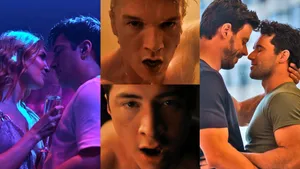
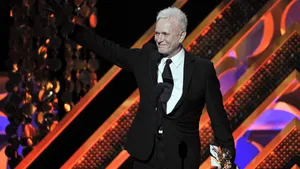







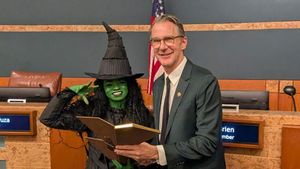
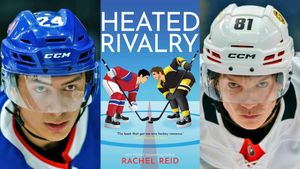
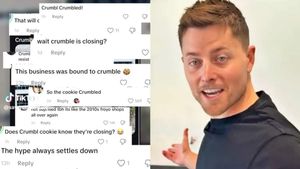





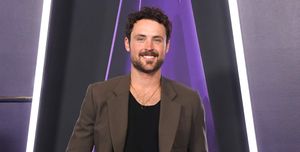

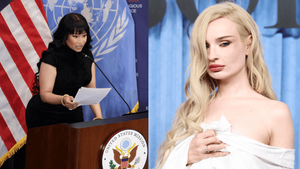






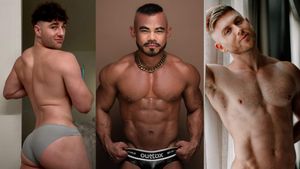




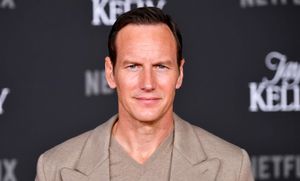
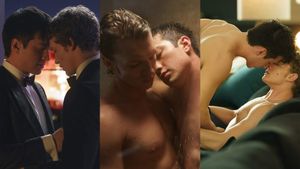







Charlie Kirk DID say stoning gay people was the 'perfect law' — and these other heinous quotes